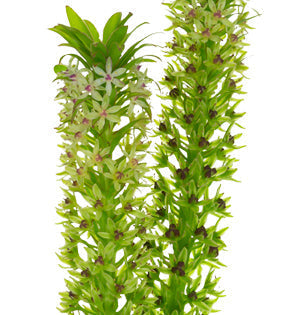
Pineapple Lily
A tall central spike covered in small, star-shaped flowers that resembles a pineapple. At the top of the flower spike, a tuft of leafy bracts adds to the pineapple-like appearance.
Welcome to our Flower Library. In these pages you will find over 134 of the most common florist flowers and foliages used in floral design. We have pictured and detailed the common and botanical names of each flower along with it's seasonal availability and colors. You may search for a flower by name or by image. For each flower we have detailed the care and conditioning methods, storage temperatures, design notes and problems specific to each flower. Also included in these pages are interesting facts about each flower including the country or region of origin, how the flower came to named, and historical notes about the flower.
.jpg?v=0)
Enter your keyword search above, or browse the library below.
There were no search results for the search "". Please try using more general terms to get more results.
Results found for ""
Result pages:

A tall central spike covered in small, star-shaped flowers that resembles a pineapple. At the top of the flower spike, a tuft of leafy bracts adds to the pineapple-like appearance.

The leaves of pitcher plants are modified into specialized structures called pitchers. These pitchers are typically elongated, hollow, and tubular, resembling a pitcher or jug, hence the name. The shape can vary from cylindrical to trumpet-like, depending on the species.

Pittosporum plants are prized for their glossy, leathery leaves, which vary in shape and size depending on the species and cultivar. Leaves can be lance-shaped, oval, or elongated, and often have wavy or serrated margins.

Plumosa foliage is characterized by its finely divided, slender, needle-like leaflets that resemble delicate feathers or plumes. The leaves are arranged in a graceful, airy manner on arching stems creating a lush and cascading effect.

What is perceived as poinsettia flowers are actually bracts, which are modified leaves below the actual flowers. The bracts are vibrant and colorful. The true flowers, called cyathia, are the small yellow or green structures nestled at the center of the bracts.

The blossom of the Oriental Poppy is quite large, measuring 4 to 6 inches in diameter when fully open. The petals are papery-thin and translucent, giving them an almost ethereal appearance. They are often crinkled or wrinkled along the edges, adding texture to the flower. At the heart of the blossom is a prominent dark-colored center, often deep purple or black.

Poppy pods are the seed pods of the opium poppy. The pods are typically oval or round in shape, with a slightly tapered end.

Solitary cup-shaped blossoms atop slender, hairy stems. The flowers can be up to three inches wide with petals that are often crinkled and papery in texture, giving them a delicate appearance.

Small, round to oval-shaped fruits that grow in clusters along the branches of privet shrubs.

Large, round, dramatic flower heads surrounded by colorful bracts at the end of long, woody stems. King Protea flower heads up to 12 inches across on stems 24 to 36 inches long. Queen Protea flower heads 5 to 7 inches across on stems 18 to 24 inches long. Pink Mink flower heads 3 inches across on stems 16 to 24 inches long.

Small, flat, and heart-shaped flowers on thin, delicate, drooping stems. The flower heads tremble or "quake" in the wind, giving the plant its common name.


Small, showy, multi-petaled, bowl-shaped flowers, 1 to 4 inches across. Single and double blossoms on slender delicate stems, 10 to 20 inches long.
Unlike the traditional, densely petaled ranunculus, the butterfly variety features semi-double, slightly cupped blooms with a shimmering, almost translucent quality to their petals, often described as having a satin-like finish.

Slender, long, arching leaves, 8 to 12 inches in length and less than an inch wide that are green with distinctive white or cream stripes running along their length. The leaves are flexible and bend easily, giving the foliage a graceful and flowing appearance.

Tiny dense clusters of flowers at the tips of the branches. Each tiny flower is star-shaped with five petals. Each flower head consists of numerous tiny individual flowers arranged in a tight, spherical shape, resembling a puff of cotton.

Garden roses come in various shapes and sizes, ranging from delicate, single-petaled blooms to large, densely packed flowers with many layers of petals.

Hybrid Tea roses typically bear large, single blooms on long, straight stems. The blooms often feature a high center point with spiraling petals that gradually unfurl as the flower matures. The petals are usually pointed and may form a classic "teacup" shape, giving rise to the name "Hybrid Tea."

Spray roses are hybrid tea roses with smaller blossoms and multiple a stems, each with a bloom branching out from a center stem. giving the appearance of a cluster or spray. The small blooms often feature a high center point with spiraling petals that gradually unfurl as the flower matures.